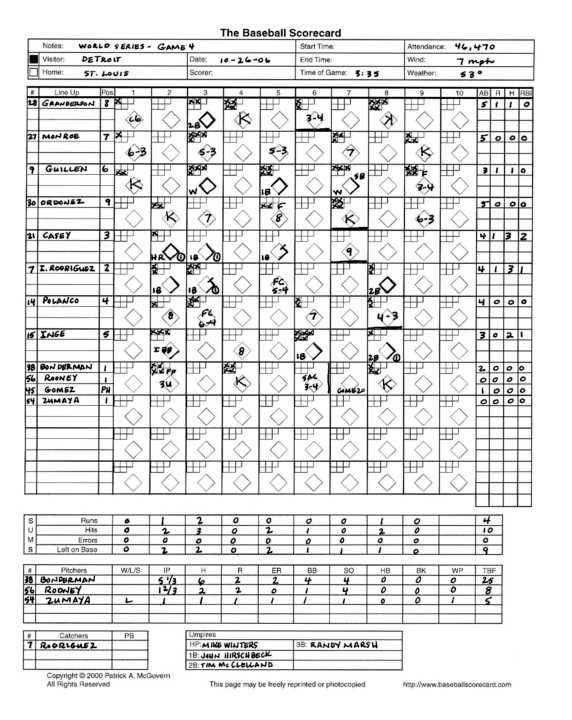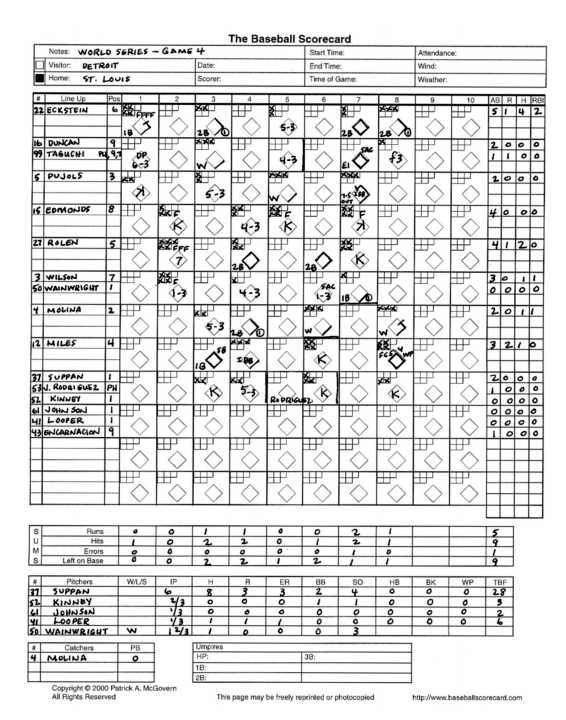Read The New Ballgame: Understanding Baseball Statistics for the Casual Fan Online
Authors: Glenn Guzzo
The New Ballgame: Understanding Baseball Statistics for the Casual Fan (12 page)

Enter 6-3 for a groundball that the shortstop fields and throws to the
first baseman.
Make it "DP 6-4-3" or simply 6-4-3 for a double play started by the
shortstop, with a putout and relay throw by the second baseman.
Make it "FC 4-6" or simply "4-6" for a fielder's choice where the second baseman tosses to the shortstop covering for the putout.
Make it 3-1 for a groundball to the first baseman who flips to the pitcher
covering first.
Make it "3u" for a groundball to the first baseman who steps on first
base to record the out unassisted.
For a sacrifice bunt, make it "SAC 5-3" when the third baseman throws
out the hitter at first, but it advances the runner a base.
"K" is so widely recognized as the symbol for a strikeout that pitcher statistics for strikeouts are sometimes expressed as "Ks."
A swinging strikeout is a "K." A called strikeout is a "K" backwards.
Single = lB
Double = 2B
Triple = 3B
Home run = HR
Walk = W or BB (IW or IBB for an intentional walk)
Hit by Pitch = HBP or HB
Error = E (followed by the fielding position of the defender; e.g. E6)
In all cases, darken (or begin to draw, depending on your scorecard) the
edges of a diamond to show the player's progress on the bases.
If the batter reaches first base, simply darken the edge between home
plate and first base only.
If the batter reaches second base, darken both the edge between home
and first and the edge between first and second.
To locate a hit, simply add the fielding position. A single to center field
becomes 1B8. An infield hit might be 1B5. If you want more specificity on
balls hit into the gaps, 2B78 would indicate a double to left-center.
Variation: Some scorekeepers, seeking to avoid confusion with
the numeric system for outs, avoid numbers and letters when recording hits. Instead, they use horizontal strokes-one for a single, two for a double and so on. Then, extending from the topmost
stroke, another stroke showing the direction of the hit.
Each time a player advances bases on teammate at-bats, darken the edges of
the diamond accordingly.
If he steals a base (SB), or advances on a balk (BK), wild pitch (WP)
or passed ball (PB), also enter the code along the edge representing that advance.
When a baserunner is out, simply show it after the last base he achieved successfully.
For example, if he fails to make it to second on a fielder's choice started
by the shortstop, enter 6-4 along the edge of the diamond between first and
second base.
If he is thrown out at the plate by the right fielder, enter 9-2 along the
edge of the diamond between third base and home plate.
If he is caught stealing third, a simple CS along the edge between second and third base will suffice.
If he is picked off first base, enter PO (or "po" if you are using PO for
popout) along the edge between first and second base.
Enter the names of substitute players in the batting order spot where they have
been placed. Usually, this is under the player they replace, but not always:
Teams will sometimes make "double switches" to delay a new pitcher's time
at bat.
When a batter leaves the lineup, draw a dark vertical line on the right
edge of the square containing his final plate appearance.
When a pitcher leaves the game, draw a dark horizontal line at the bottom of the square of the last batter he faced (that's on the other team's lineup
sheet).
Officially, all fielders who touch the ball in the process of recording an out are
part of the play. So a groundball deflected by the pitcher that is then gloved by
the second baseman who throws to first in time for the out is officially scored
1-4-3. (This is why "DP" is the preface for double plays.)
Similarly, a runner thrown out at home by the shortstop who cut off the
throw from the left fielder is retired 7-6-2.
This can get messy on rundown plays where several fielders may be
involved and some may handle the ball more than once.
The edge of the diamond between home and first can be used for any
of several purposes:
• Some scorekeepers put the batter result here rather than in the center
of the square.
• Some scorekeepers record runs batted in here. One way to do so is to
write and circle the number of RBIs in that plate appearance.
• Some scorekeepers use a circled 1, 2 or 3 here to show the number
of outs in the inning. Many scorekeepers don't need this assistance,
but it can be useful for finding the out-makers swiftly.
Just about every scorecard also includes space to add up the total numbers of runs, hits, errors, and men left on base for each inning, as well as an
area to tally the final offensive stats for each player. Most scorecards also contain a pitching chart of some sort. After a pitcher has left a game you can
use this area to record his total stats-innings pitched, runs given up, earned
runs, hits, walks, strikeouts, and wild pitches. At the end of a game, give the
appropriate pitchers a win, loss or save.
When you have decided how you'd like to keep score, you may obtain scoresheets in several ways: download samples for free from various
Internet sites, including www.baseball-almanac.com; find books of baseball scoresheets in retail stores or from the publisher of this book; copy the
scoresheets that come with simulation board games such as Strat-O-Matic; or
purchase a program the next time you enjoy a game at your local ballpark.


ATV SCREEN NEAR YOU

 f statistics were not the language of
f statistics were not the language of
baseball, televised games would tell
us that. Television has so many other ways
to communicate-moving pictures, spoken words, game sounds-that stats
would hardly be necessary, unless they are necessary. In fact, the stats get
about as much air time as the announcers. The stats are so fundamental to
game coverage that the broadcasts take it for granted that their viewers have
a certain amount of preexisting knowledge.
So if you're new to baseball, a TV game can be a rapid education, or it
can leave you feeling hopelessly behind, depending on your aptitude.
In this chapter we aim to make that transition painless by preparing you
for what you will see and hear on TV.
We don't want to neglect radio, where stats also have an important role.
But it's painful to admit this: Baseball statistics play better on television than
they do on radio.
Those of us who see something much more profound in baseball's
numbers than mere accounting would be more than content to link them to
the aesthetic beauty of baseball on the radio. In the way that reading a book
can be more fulfilling than watching the movie based on that book, listening
to a baseball game on the radio can be more satisfying than watching it. In
both cases, the imagination paints the more perfect picture.
Alas, when it comes to statistics, the magic of baseball on the radio
is an arcane art. We might suppose that with its moving pictures and video
replays, TV would rely less on numbers. But at their best, stats are seen, not
heard. We all remember more of what we see than what we hear, and if a stat
is not remembered, it's just a number. It ought to be more-the context that
gives this at-bat and this game significance.
For a TV game, that context is more important than ever. It fuels the
anticipation that keeps a viewer paying attention in twenty-first century TV's
constant war with distraction.
Today's sports TV consumers are a study in adult attention deficit disorder. They're at the home computer, glancing at the TV for highlights. They're
at the sports bar, sneaking peeks at the game. They might even be reading this
book while the game is on. If they are watching most of the game, they almost
certainly have the remote in hand and might be using the mute button while
listening to U2, or the friend they just called.
Without close concentration, audio stats are a lost cause. Radio baseball
requires focus to track even the most basic baseball numbers: pitch count, the
runners on base, and the number of outs, among other things. To an escalating
degree, TV overcomes this with graphic displays. The game-situation strip
showing the score, the baserunners, the inning, the number of outs, and the
pitch count is so ubiquitous today that it's easy to forget that the technique is
only a few years old.
The game-situation strip outwits the mute button and solves the predicament of distracted viewers checking in for updates. These techniques
also relieve the TV announcers of the duty radio announcers have to perform
all the time. Legendary announcer Red Barber, who began calling Brooklyn
Dodgers games before television, used to have a three-minute timer as a reminder to recite the score at least that often. Today, an adequately staffed TV
game has a stats maven who feeds relevant data to the announcers and cues
the producer to display prepackaged graphics prepared by a supporting cast
of number crunchers.
At the same time, televised games are not the only source of stats on the
small screen: Shows reviewing the day's games and statistics are fast becoming nearly as popular as the games themselves, what with their comprehensive
content and hilarious on-air personalities, and they throw just as many stats
at fans as the games themselves do, if not more. These fast-paced overviews
require attention and demand a prerequisite understanding of statistics.
To illustrate the stats you'll need a command of to fully enjoy baseball
on television, we offer a glimpse at a couple of characteristic broadcasts: a
game aired on Fox Sports from the 2005 regular season and an episode of
ESPN's Baseball Tonight. For the game, it's important to note that, during the regular season, sports announcers are much more willing to delve deeply
into obscure stats than they would during a World Series game when more
casual fans are viewing and the networks need to keep things simple. As for
Baseball Tonight, there really is no watering it down: They hit the stats and
they hit them hard for the entire hour of broadcast.
